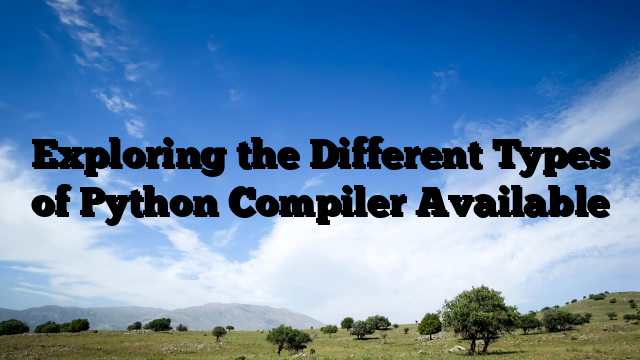- Exploring the Amazing Python Features
- Understanding Memory Management in Python: A Comprehensive Guide
- Exploring the Benefits of Python Programming
- Exploring the Best IDE for Python Programming
- Java or Python: Which Language Holds the Key to Your Programming Success?
- PHP vs Python: Which Language is Best for Your Project?
- From Bugs to Brilliance: Harnessing Python Exceptions for Powerful Coding
- Types of inheritance in python
- How to Create an Android App with Python
- Python vs C++: Uncovering the Best Programming Language for Your Needs
- How should I start learning Python?
- Python Dictionary: A Comprehensive Guide to Understanding and Using Dictionaries
- Introduction to Python Generators: What They Are and How to Use Them
- A Comprehensive Guide to Understanding Python else if Statements for Optimal Decision Making
- Boost Your Programming Skills with Python NumPy: An In-Depth Exploration of Its Features
- Exploring the Different Types of Python Compiler Available
- Understanding Python Tuples: A Comprehensive Guide
- Python List: A Comprehensive Guide to Working with Lists in Python
- Exploring Logical Operators in Python: A Comprehensive Guide
- Exploring the Different Types of Python Operators: A Comprehensive Guide
- A Comprehensive Guide to Python Datatypes
- Introduction to Python for Beginners
- Python Download: Your Comprehensive Guide to Getting Started
- how to comment out multiple lines in python
Python dictionary is an essential data structure for any programmer. They are powerful, versatile, and can be used to store and retrieve data quickly and efficiently. This comprehensive guide to understanding and using dictionaries in Python will provide you with the knowledge and skills you need to become a proficient Python programmer. You will learn about the different types of dictionaries, how to create and modify them, and how to use them in your programs. You will also learn about the different methods and techniques for working with dictionaries, as well as how to debug and optimize your code. With this guide, you will be able to confidently use dictionaries in your Python programs and take your programming skills to the next level.
What is a Python Dictionary?
A Python Dictionary is a collection of key-value pairs. It is a data structure that is mutable, unordered, and indexed. It is also known as an associative array, hash table, or map.
Python dictionaries are used to store data in a key-value format. The key is used to identify the value, and the value is the data associated with the key. The keys must be unique and immutable, meaning they cannot be changed once they are created. The values can be of any data type, including strings, integers, floats, and lists.
Python dictionaries are created using curly braces ({}). Each item in the dictionary is separated by a comma and consists of a key and a value. The key is followed by a colon (:) and the value is placed after the colon. For example, if you wanted to create a dictionary with two items, the syntax would look like this:
my_dict = {
“key1”: “value1”,
“key2”: “value2”
}
To access the value associated with a key, you can use the square bracket notation. For example, if you wanted to access the value associated with the key “key1”, you would use the following syntax:
my_dict[“key1”]
This would return the value “value1”.
Python dictionaries are commonly used to store data in a structured format. They are also used to create mappings between two or more data sets. For example, you could use a dictionary to map country codes to their corresponding countries.
Python dictionaries are an incredibly powerful data structure and are used in many applications. They are easy to use and can be used to store and access data quickly and efficiently.
How to Create and Manipulate a Python Dictionary
Python Dictionary is a powerful data structure that allows you to store and manipulate data in a variety of ways. It is an unordered collection of key-value pairs, where each key is unique and is associated with a single value. A dictionary is an effective way to store and access data in Python.
Creating a Python Dictionary is simple. All you need to do is define the key-value pairs in curly brackets, separated by commas. The syntax for creating a dictionary is as follows:
my_dict = {key1: value1, key2: value2, ...}
For example, if you wanted to create a dictionary of fruits and their colors, you could do so like this:
fruits_colors = {'apple': 'red', 'banana': 'yellow', 'grape': 'purple'}
Once you have created a dictionary, you can manipulate it in a variety of ways. You can add new key-value pairs, remove existing ones, and modify existing values. To add a new key-value pair, you can use the update() method. For example, if you wanted to add the color of an orange to the dictionary, you could do so like this:
fruits_colors.update({'orange': 'orange'})
To remove a key-value pair, you can use the pop() method. For example, if you wanted to remove the color of a banana from the dictionary, you could do so like this:
fruits_colors.pop('banana')
Finally, to modify an existing value, you can use the update() method. For example, if you wanted to change the color of an apple from red to green, you could do so like this:
fruits_colors.update({'apple': 'green'})
Python Dictionary is a powerful data structure that allows you to store and manipulate data in a variety of ways. It is an effective way to store and access data in Python. With the methods discussed above, you can easily create and manipulate a Python Dictionary.
Understanding the Different Types of Keys and Values
Python Dictionary is a powerful data structure that can store and organize data in a variety of ways. It is a collection of key-value pairs, where each key is associated with a value. Keys and values can be of any data type, including strings, integers, floats, and even other dictionaries.
Keys are used to identify and access the values in a dictionary. They must be unique and immutable, meaning they cannot be changed once they are created. Common types of keys include strings, integers, and tuples.
Values are the data associated with a particular key. They can be of any data type, including strings, integers, floats, and even other dictionaries. Values can also be collections of data, such as lists and tuples.
It is important to understand the different types of keys and values when working with dictionaries in Python. Knowing the types of keys and values will help you to properly access and manipulate the data stored in a dictionary.
For example, if you want to access a value associated with a particular key, you must use the correct type of key. If you use an incorrect type of key, you will not be able to access the value. Similarly, if you want to add a new value to a dictionary, you must use the correct type of key.
Understanding the different types of keys and values is essential for working with dictionaries in Python. Knowing the types of keys and values will help you to properly access and manipulate the data stored in a dictionary.
Utilizing Dictionary Methods for Maximum Efficiency
Python Dictionary is a powerful data structure that can be used to store and retrieve data with maximum efficiency. Dictionary methods allow for fast and easy access to data, making them a great choice for applications that require quick and accurate retrieval of information.
Dictionaries are composed of key-value pairs, where the key is used to identify the data and the value is the data itself. For example, a dictionary could contain a key of “name” and a value of “John”. This allows for easy retrieval of the data associated with the key.
Dictionary methods are used to access, add, modify, and delete data from a dictionary. These methods are very useful for quickly accessing and manipulating data. For example, the get() method can be used to retrieve a value from a dictionary, while the setdefault() method can be used to add a new key-value pair to a dictionary.
Utilizing dictionary methods for maximum efficiency can be beneficial in many applications. By taking advantage of the speed and accuracy of dictionary methods, applications can quickly and accurately retrieve and manipulate data. This can help to reduce development time and improve the performance of applications.
In addition, dictionaries can be used to store large amounts of data. By utilizing dictionary methods, developers can quickly and easily access and manipulate large amounts of data. This can help to reduce the amount of time and resources needed to manage and store data.
Overall, utilizing dictionary methods for maximum efficiency can be a great way to quickly and accurately access and manipulate data. By taking advantage of the speed and accuracy of dictionary methods, developers can reduce development time and improve the performance of applications.
Common Use Cases for Python Dictionaries
Python dictionaries are one of the most versatile and powerful data structures available in the language. They are used to store key-value pairs, and are incredibly useful for organizing and accessing data. Python dictionaries are commonly used in a variety of use cases, including:
1. Storing and accessing user data: Python dictionaries are often used to store user data, such as preferences, settings, and other information. This data can then be accessed quickly and easily using the dictionary’s key-value pairs.
2. Organizing and accessing large datasets: Python dictionaries are also commonly used to organize and access large datasets. This is because dictionaries are optimized for fast lookups, making them ideal for quickly accessing large amounts of data.
3. Caching data: Python dictionaries are also often used as a form of caching, as they can store data in memory and quickly access it when needed. This is useful for optimizing applications and improving performance.
4. Creating custom objects: Python dictionaries can also be used to create custom objects, such as classes and instances. This is a powerful way to create custom data structures that can be used in a variety of applications.
5. Parsing JSON data: Python dictionaries are also commonly used to parse JSON data. This is because JSON data is structured as key-value pairs, making it easy to parse and access using a dictionary.
Overall, Python dictionaries are incredibly versatile and powerful data structures that can be used in a variety of use cases. They are optimized for fast lookups, making them ideal for quickly accessing large amounts of data. They can also be used to store user data, create custom objects, and parse JSON data.
Python dictionaries are a powerful and versatile tool for organizing and manipulating data. They provide an efficient way to store and access data, allowing users to quickly access and modify data as needed. This comprehensive guide to understanding and using dictionaries in Python provides a comprehensive overview of the data structure, its syntax, and how to use it in various applications. With the help of this guide, users can easily learn to use dictionaries in Python to store and manipulate data with ease.


















